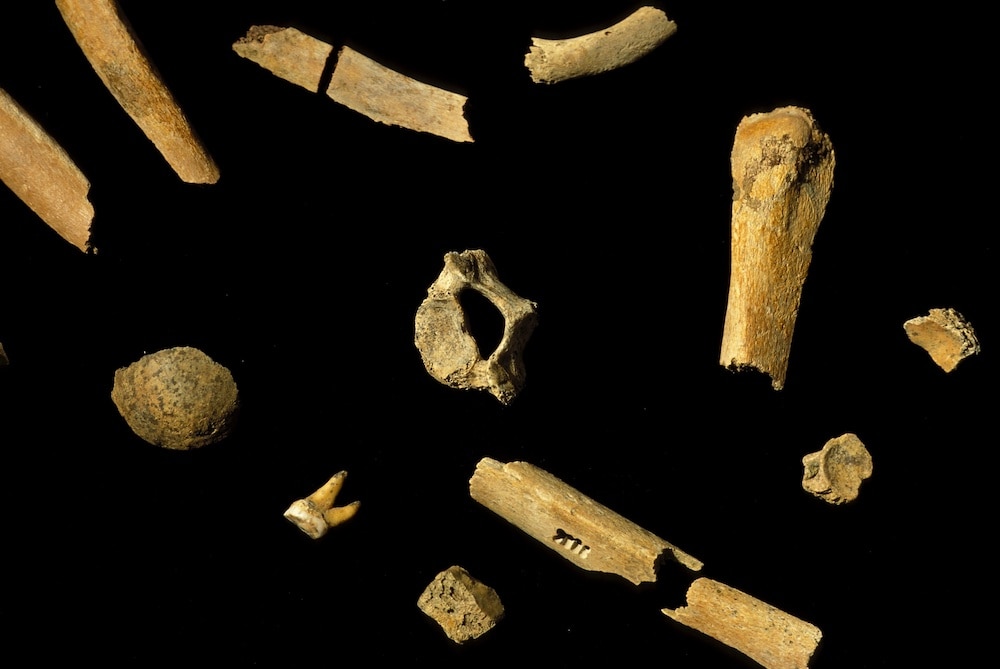Create a free profile to get unlimited access to exclusive videos, sweepstakes, and more!
Human vertebra fossil tells us where we came from — and how we got where we are
We still had a long way to go before taking over the planet.

Because our ancestors didn’t exactly have smartphones and social media to track where they were going, we need their bones (like the ones above) to tell us instead.
Human predecessors didn’t just decide to venture out of Africa en masse. Migrations to Eurasia happened in waves, and now the discovery of a 1.5-million-year-old fossil vertebra from an ancient hominid species is revealing more about where they went. It was only half a million years earlier that hominids had started to leave Africa and set foot in Eurasia. Ubeidiya, Isreal, is one of the rare places where evidence of the first human migrations is preserved.
The fossil (below), first unearthed in 1966, was a relic from an archaeological site in Ubeidiya. Researcher Alon Barasch of Bar Ilan University, who led a study recently published in Scientific Reports, and his team found that this vertebra, the oldest human fossil in Israel, differed from fossils of another ancient human population that left Africa early on and settled in Dmanisi, Georgia. It is the first evidence that two human species migrated out of Africa on their own.
“Ubeidiya represents a more complex culture known as the Achulean, whose tools were more difficult to produce and used for more tasks,” Barasch told SYFY WIRE. “It is not necessarily indicative of different environments, but of better usage of an environment.”
The hominid population in Ubeidiya was found to be a larger and more advanced species of hominid than that in Dmanisi. Hominids are first thought to have arrived in Dmanisi 1.8 million years ago, and belonged to a more primitive species. They were not only shorter in stature, but making their tools didn’t require much more than chipping at one stone with another. These tools were probably for cracking open animal bones to get to the marrow inside. The Achuleans, a species that emerged later, were capable of creating tools for more purposes.
Our ancestors appear to have grown bigger as they evolved. When early hominids first diverged from apes, they were barely over 3 feet tall and about 40 to 50 pounds. Barasch thinks the human ancestors that lived in Dmansi could be Homo habilis or a smaller Homo erectus. They were around the same height and slightly heavier. The Ubeidiya fossil is the remnant of a species that had evolved further, which was closer to the average Homo Erectus in stature and build. This individual would have been up to six feet tall if they had reached adulthood.
“Lower back vertebra fuse around 6-10 years of age,” said Barasch. “Since the Ubeidiya vertebra is not yet fused, and since we are not sure that early hominids grew the same way as modern humans, we assume it to be 6-12, but it is almost as big as an adult modern human vertebra.”
It is the growth process of human bones that told him this. Bones will stop growing when they fuse together, but some can offer more insight than others. In specimens with a pelvis, the last bone to fuse does so at about 25 (which is also when the brain matures); how much it has fused can give away an approximate age. Skull fusion can also be an indicator of age. The Ubeidiya specimen is just one lumbar (lower back) vertebra, but the researchers were able to make out that the individual must have been 4’9” to 5”— tall for a preteen of a species so ancient.
But why was there even a hominid exodus from Africa? Maybe early humans followed animals they hunted and ended up migrating with them, since herbivores keep moving as they deplete an area. Dmansi is more of a dry savannah while Ubeidiya (above) is more humid. Fossils of creatures that have been gone from Israel for eons, such as jaguars and giraffes and hippopotami, have surfaced, which might mean Ubeidiya was more of a lush paradise. There is also ancient evidence of sudden climate shifts driving entire populations elsewhere. Barasch suspects this.
“We don’t know, but possible climatic change that led big game into the Levant and Eurasia is the prime suspect,” he said. “Maybe it’s just human nature to migrate into the unknown, even 1.5 million years ago.”




























